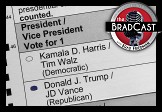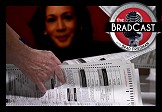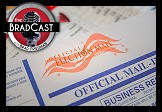An instructional web page, explaining the ES&S touch-screen electronic voting machines in use during Florida's disputed FL-13 U.S. House Election gives faulty information to voters about the way the county's paperless voting systems works, The BRAD BLOG has learned.
The information offered on the county's election website, concerning the crucial process during which voters might choose to adjust any "undervotes" found on their electronic "ballots" at the end of the voting process, is misleading and incorrect. According to several sources, the systems in use during the contested November 7th U.S. House race between Vern Buchanan (R) and Christine Jennings (D) did not operate as advertised by the Sarasota County website.
 The county web page in question is described as "a technical look at how the ES&S iVotronic touch screen system works." Yet, Sarasota's ES&S iVotronic systems, apparently, didn't work as described on the site.
The county web page in question is described as "a technical look at how the ES&S iVotronic touch screen system works." Yet, Sarasota's ES&S iVotronic systems, apparently, didn't work as described on the site.
The "VOTE button" on the iVotronic, as explained by the text on the website, will cast the vote only after the summary page is given to the voters, allowing them to explicitly approve or disapprove of any undervotes found on their "ballots."
"The iVotronic will review the ballot for any races for which the voter did not cast a vote (undervote), and asks if this is the intent of the voter," according to the webpage. The voter is then said to receive a YES or NO option to confirm their intention of undervoting in the particular race(s).
(The webpage is here. Click the #5 option to see how the "VOTE button" on the system is supposed to work. A screenshot of the page follows at the end of this article.)
Lowell Finley, however, an attorney for VoterAction.org --- one of several non-partisan organizations leading a voter lawsuit demanding a revote in the election --- tells The BRAD BLOG that "the statement on the Sarasota website is false" and that voters were not given such an option on November 7th.
We also inquired about the matter on Friday afternoon with the office of "the Honorable" Kathy Dent, Sarasota County's Supervisor of Elections...
 Someone who answered the phone in the Administrative Office, but subsequently refused to either give her name or allow herself to be quoted even off the record, confirmed that there is no explicit "YES or NO" confirmation concerning undervotes at the end of the voting process before the "ballot" is finally cast.
Someone who answered the phone in the Administrative Office, but subsequently refused to either give her name or allow herself to be quoted even off the record, confirmed that there is no explicit "YES or NO" confirmation concerning undervotes at the end of the voting process before the "ballot" is finally cast.
(As a side note, the same person at the Sarasota Elections office said that Supervisor Dent --- who has still yet to resign, but should --- had just left to go on a week's vacation. Seems rather ill-advised timing, given the important ongoing events unfolding down there at this moment, but what do we know.)
The contested election now stands with just 369 votes between Republican Buchanan and Jennings according to the state certified results. But some 18,000 votes were lost from "ballots" which failed to register any vote at all for either candidate in Jennings's strongest areas. That undervote rate, approximately 15%, is far higher than any other county in the same district for the same race. The paper Absentee Ballot undervote rate in the same county for that same race was just 2.6%, which would seem to counter the disingenuous claims of Buchanan and his supporters who claim that voters purposely chose not to vote in that particular race for some reason.
Many voters have given statements to the Jennings campaign, to local newspapers, and to attorneys who are challenging the election claiming they were disenfranchised after they had tried several times to vote for Jennings, but the machine failed to register their vote.
The complete misleading text from the Sarasota County web page --- which both Finley and the official from the Sarasota County Supervisors of elections office confirmed is inaccurate --- follows below, along with Finley's explanation of how the confirmation page on the voting machines actually worked and a screenshot of the inaccurate information on the Sarasota County Elections website...
The VOTE button finalizes the voter's selections and casts his/her vote, then clears the screen in preparation for the next voter.
Upon proper selection of choices, the voter is brought to a summary screen which displays those choices on each item on the ballot. At this time, the voter can make changes by touching the ballot item on the summary screen, whereby they will go back to that item to review or change a choice. When finished, the review screen reflects the updated selections. The iVotronic will review the ballot for any races for which the voter did not cast a vote (undervote), and asks if this is the intent of the voter. Upon selection of "YES", the VOTE button will illuminate and the voter will be prompted to press the button to cast the ballot. If the undervote question is answered "NO", then the voter will have the opportunity to return to the ballot and make a choice. At this time the voter can review the summary screen and press the VOTE button to cast the ballot.
Finley explained to The BRAD BLOG in a brief Email late last week how the so-called confirmation process on the voting machines actually worked (or didn't) on November 7th in Sarasota's FL-13 race...
UPDATE 1/23/07: Political Cortex moves the ball forward in noting that Florida statute "covering the 'electronic voter interface' (video display ballot for a typical voter, audio ballot for a sight-impaired voter)" would seem to indicate that Sarasota County is in violation of the law by not asking for explicit voter approval concerning undervotes. Here's the relevant passage from the Florida Election Code [appendix definitions and pp. 20-22]...
The system must communicate to the voter the fact that the voter has failed to vote in a race (under vote) or has failed to vote the number of allowable candidates in any race (under vote) and require the voter to confirm his intent to undervote before casting the ballot.(Hat-tip Jim Soper for the heads up to the incorrect info on the Sarasota website!)


 How (and Why!) to 'Extend an Olive Branch' to MAGA Family Members Over the Holidays: 'BradCast' 11/21/24
How (and Why!) to 'Extend an Olive Branch' to MAGA Family Members Over the Holidays: 'BradCast' 11/21/24 'Green News Report' 11/21/24
'Green News Report' 11/21/24
 Former Federal Prosecutor: Trump Must Be Sentenced in NY Before Taking Office Again: 'BradCast' 11/20/24
Former Federal Prosecutor: Trump Must Be Sentenced in NY Before Taking Office Again: 'BradCast' 11/20/24 'Bullet Ballot' Claims, Other Arguments for Hand-Counting 2024 Battleground Votes: 'BradCast' 11/19/24
'Bullet Ballot' Claims, Other Arguments for Hand-Counting 2024 Battleground Votes: 'BradCast' 11/19/24 'Green News Report' 11/19/24
'Green News Report' 11/19/24 Trump Already Violating Law (He Signed!) During Transition: 'BradCast' 11/18/24
Trump Already Violating Law (He Signed!) During Transition: 'BradCast' 11/18/24 Sunday 'Into the Gaetz of Hell' Toons
Sunday 'Into the Gaetz of Hell' Toons Computer Security Experts Ask Harris to Seek Hand-Counts Due to Voting System Breaches: 'BradCast' 11/14/24
Computer Security Experts Ask Harris to Seek Hand-Counts Due to Voting System Breaches: 'BradCast' 11/14/24  'Green News Report' 11/14/24
'Green News Report' 11/14/24 Trump Criminal Cases Fade After Election as GOP 'Does Not Believe in Rule of Law': 'BradCast' 11/13/24
Trump Criminal Cases Fade After Election as GOP 'Does Not Believe in Rule of Law': 'BradCast' 11/13/24 Climate Advocates Brace for Fight With Trump 2.0: 'BradCast' 11/12/24
Climate Advocates Brace for Fight With Trump 2.0: 'BradCast' 11/12/24 'Green News Report' 11/12/24
'Green News Report' 11/12/24 Let It All Out: 'BradCast' 11/11/24
Let It All Out: 'BradCast' 11/11/24 Sunday 'Like it or Not' Toons
Sunday 'Like it or Not' Toons Not All Bad: Abortion Rights Won Big (Almost) Everywhere: 'BradCast' 11/7/24
Not All Bad: Abortion Rights Won Big (Almost) Everywhere: 'BradCast' 11/7/24 'Green News Report' 11/7/24
'Green News Report' 11/7/24 U.S. CHOOSES CONVICTED CRIMINAL, ADJUDICATED RAPIST: 'BradCast' 11/6/24
U.S. CHOOSES CONVICTED CRIMINAL, ADJUDICATED RAPIST: 'BradCast' 11/6/24 ELECTION DAY 2024: Tea Leaves, Probs for Voters, What's Next: 'BradCast' 11/5/24
ELECTION DAY 2024: Tea Leaves, Probs for Voters, What's Next: 'BradCast' 11/5/24 'Closing Arguments' for Undecideds, Third-Party Voters: 'BradCast' 11/4/24
'Closing Arguments' for Undecideds, Third-Party Voters: 'BradCast' 11/4/24 The GOP 'Voter Fraud' Before the Storm: 'BradCast' 10/31/24
The GOP 'Voter Fraud' Before the Storm: 'BradCast' 10/31/24 'Closing Arguments'with Digby and Driftglass: 'BradCast' 10/30/24
'Closing Arguments'with Digby and Driftglass: 'BradCast' 10/30/24 Trump Promises to be a Lawless, Authoritarian President. Believe Him: 'BradCast' 10/29/24
Trump Promises to be a Lawless, Authoritarian President. Believe Him: 'BradCast' 10/29/24 Ballots Burn, Billion-aires 'Obey in Advance', Callers Ring In: 'BradCast' 10/28/24
Ballots Burn, Billion-aires 'Obey in Advance', Callers Ring In: 'BradCast' 10/28/24 Musk's Privatized Internet Satellite System Threatens U.S. National Security
Musk's Privatized Internet Satellite System Threatens U.S. National Security
 VA GOP VOTER REG FRAUDSTER OFF HOOK
VA GOP VOTER REG FRAUDSTER OFF HOOK Criminal GOP Voter Registration Fraud Probe Expanding in VA
Criminal GOP Voter Registration Fraud Probe Expanding in VA DOJ PROBE SOUGHT AFTER VA ARREST
DOJ PROBE SOUGHT AFTER VA ARREST Arrest in VA: GOP Voter Reg Scandal Widens
Arrest in VA: GOP Voter Reg Scandal Widens ALL TOGETHER: ROVE, SPROUL, KOCHS, RNC
ALL TOGETHER: ROVE, SPROUL, KOCHS, RNC LATimes: RNC's 'Fired' Sproul Working for Repubs in 'as Many as 30 States'
LATimes: RNC's 'Fired' Sproul Working for Repubs in 'as Many as 30 States' 'Fired' Sproul Group 'Cloned', Still Working for Republicans in At Least 10 States
'Fired' Sproul Group 'Cloned', Still Working for Republicans in At Least 10 States FINALLY: FOX ON GOP REG FRAUD SCANDAL
FINALLY: FOX ON GOP REG FRAUD SCANDAL COLORADO FOLLOWS FLORIDA WITH GOP CRIMINAL INVESTIGATION
COLORADO FOLLOWS FLORIDA WITH GOP CRIMINAL INVESTIGATION CRIMINAL PROBE LAUNCHED INTO GOP VOTER REGISTRATION FRAUD SCANDAL IN FL
CRIMINAL PROBE LAUNCHED INTO GOP VOTER REGISTRATION FRAUD SCANDAL IN FL Brad Breaks PA Photo ID & GOP Registration Fraud Scandal News on Hartmann TV
Brad Breaks PA Photo ID & GOP Registration Fraud Scandal News on Hartmann TV  CAUGHT ON TAPE: COORDINATED NATIONWIDE GOP VOTER REG SCAM
CAUGHT ON TAPE: COORDINATED NATIONWIDE GOP VOTER REG SCAM CRIMINAL ELECTION FRAUD COMPLAINT FILED AGAINST GOP 'FRAUD' FIRM
CRIMINAL ELECTION FRAUD COMPLAINT FILED AGAINST GOP 'FRAUD' FIRM RICK SCOTT GETS ROLLED IN GOP REGISTRATION FRAUD SCANDAL
RICK SCOTT GETS ROLLED IN GOP REGISTRATION FRAUD SCANDAL VIDEO: Brad Breaks GOP Reg Fraud Scandal on Hartmann TV
VIDEO: Brad Breaks GOP Reg Fraud Scandal on Hartmann TV RNC FIRES NATIONAL VOTER REGISTRATION FIRM FOR FRAUD
RNC FIRES NATIONAL VOTER REGISTRATION FIRM FOR FRAUD EXCLUSIVE: Intvw w/ FL Official Who First Discovered GOP Reg Fraud
EXCLUSIVE: Intvw w/ FL Official Who First Discovered GOP Reg Fraud GOP REGISTRATION FRAUD FOUND IN FL
GOP REGISTRATION FRAUD FOUND IN FL



































